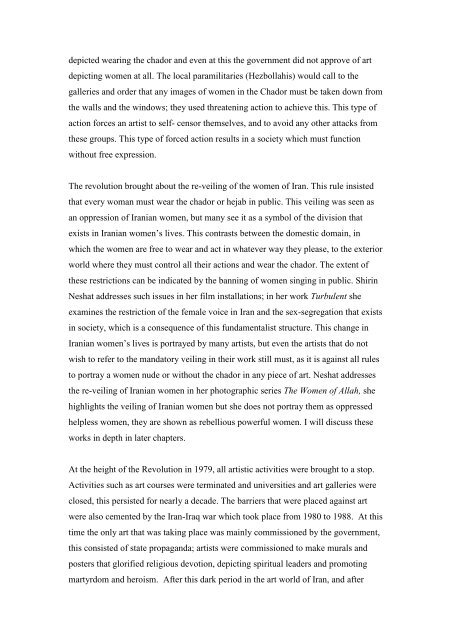A Gaze through the Veil:
A Gaze through the Veil:
A Gaze through the Veil:
Create successful ePaper yourself
Turn your PDF publications into a flip-book with our unique Google optimized e-Paper software.
depicted wearing <strong>the</strong> chador and even at this <strong>the</strong> government did not approve of artdepicting women at all. The local paramilitaries (Hezbollahis) would call to <strong>the</strong>galleries and order that any images of women in <strong>the</strong> Chador must be taken down from<strong>the</strong> walls and <strong>the</strong> windows; <strong>the</strong>y used threatening action to achieve this. This type ofaction forces an artist to self- censor <strong>the</strong>mselves, and to avoid any o<strong>the</strong>r attacks from<strong>the</strong>se groups. This type of forced action results in a society which must functionwithout free expression.The revolution brought about <strong>the</strong> re-veiling of <strong>the</strong> women of Iran. This rule insistedthat every woman must wear <strong>the</strong> chador or hejab in public. This veiling was seen asan oppression of Iranian women, but many see it as a symbol of <strong>the</strong> division thatexists in Iranian women’s lives. This contrasts between <strong>the</strong> domestic domain, inwhich <strong>the</strong> women are free to wear and act in whatever way <strong>the</strong>y please, to <strong>the</strong> exteriorworld where <strong>the</strong>y must control all <strong>the</strong>ir actions and wear <strong>the</strong> chador. The extent of<strong>the</strong>se restrictions can be indicated by <strong>the</strong> banning of women singing in public. ShirinNeshat addresses such issues in her film installations; in her work Turbulent sheexamines <strong>the</strong> restriction of <strong>the</strong> female voice in Iran and <strong>the</strong> sex-segregation that existsin society, which is a consequence of this fundamentalist structure. This change inIranian women’s lives is portrayed by many artists, but even <strong>the</strong> artists that do notwish to refer to <strong>the</strong> mandatory veiling in <strong>the</strong>ir work still must, as it is against all rulesto portray a women nude or without <strong>the</strong> chador in any piece of art. Neshat addresses<strong>the</strong> re-veiling of Iranian women in her photographic series The Women of Allah, shehighlights <strong>the</strong> veiling of Iranian women but she does not portray <strong>the</strong>m as oppressedhelpless women, <strong>the</strong>y are shown as rebellious powerful women. I will discuss <strong>the</strong>seworks in depth in later chapters.At <strong>the</strong> height of <strong>the</strong> Revolution in 1979, all artistic activities were brought to a stop.Activities such as art courses were terminated and universities and art galleries wereclosed, this persisted for nearly a decade. The barriers that were placed against artwere also cemented by <strong>the</strong> Iran-Iraq war which took place from 1980 to 1988. At thistime <strong>the</strong> only art that was taking place was mainly commissioned by <strong>the</strong> government,this consisted of state propaganda; artists were commissioned to make murals andposters that glorified religious devotion, depicting spiritual leaders and promotingmartyrdom and heroism. After this dark period in <strong>the</strong> art world of Iran, and after




